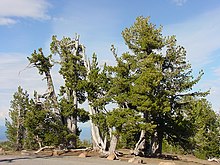| Whitebark pine | |
|---|---|

| |
| A stand of whitebark pines at Crater Lake National Park in Oregon | |
| Scientific classification | |
| Kingdom: | Plantae |
| Clade: | Tracheophytes |
| Clade: | Gymnospermae |
| Division: | Pinophyta |
| Class: | Pinopsida |
| Order: | Pinales |
| Family: | Pinaceae |
| Genus: | Pinus |
| Subgenus: | P. subg. Strobus |
| Section: | P. sect. Quinquefoliae |
| Subsection: | P. subsect. Strobus |
| Species: | P. albicaulis
|
| Binomial name | |
| Pinus albicaulis | |

| |
| Natural range of Pinus albicaulis | |
| Synonyms[3] | |
| |

Pinus albicaulis, known by the common names whitebark pine, white bark pine, white pine, pitch pine, scrub pine, and creeping pine,[4] is a conifer tree native to the mountains of the western United States and Canada, specifically subalpine areas of the Sierra Nevada, Cascade Range, Pacific Coast Ranges, Rocky Mountains, and Ruby Mountains. It shares the common name "creeping pine" with several other plants.
The whitebark pine is typically the highest-elevation pine tree found in these mountain ranges and often marks the tree line. Thus, it is often found as krummholz, trees growing close to the ground that have been dwarfed by exposure. In more favorable conditions, the trees may grow to 29 meters (95 ft) in height.
- ^ Mahalovich, M.; Stritch, L. (2013). "Pinus albicaulis". IUCN Red List of Threatened Species. 2013: e.T39049A2885918. doi:10.2305/IUCN.UK.2013-1.RLTS.T39049A2885918.en. Retrieved November 19, 2021.
- ^ NatureServe (2024). "Pinus albicaulis". Arlington, Virginia. Retrieved September 5, 2024.
- ^ "Pinus albicaulis". World Checklist of Selected Plant Families. Royal Botanic Gardens, Kew – via The Plant List. Note that this website has been superseded by World Flora Online
- ^ Earle, Christopher J., ed. (2018). "Pinus albicaulis". The Gymnosperm Database.

